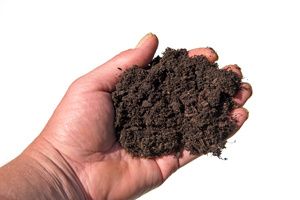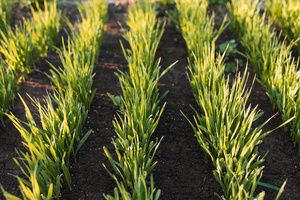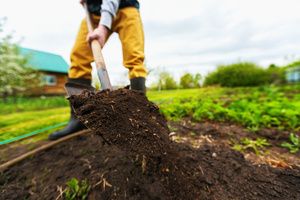As environmental concerns grow, many people are looking for ways to protect the planet. There are several practical ways that you can help your topsoil hold onto more carbon, which can help reduce greenhouse gasses in the long term and help the environment significantly.

First, it is important to understand the relationship between plants and carbon. Plants capture carbon dioxide from the Earth’s atmosphere while they are carrying out photosynthesis. This is then converted to simple sugars, which they use to fuel their growth and provide energy or use for structural compounds, such as cellulose and fibers. This is the first step in carbon sequestration, which is essentially the storage of carbon.
When the roots of a plant die or other parts of the plant are incorporated into soil, various soil-dwelling worms, insects and microorganisms start to break down compounds like the sugars for food. In the process, some carbon is released back into the atmosphere by the microorganisms in the form of carbon dioxide.
Some of the carbon, however, will remain in the soil. Some plant matter that is more difficult to break down will end up becoming a part of organic matter in the soil. This is considered a natural carbon sequestration process; plants capture the carbon dioxide and return it to the soil in a more stable form.
With this in mind, let’s explore ways you can increase plant growth in your soil and put more carbon in the ground.
Add Organic Matter
Any type of solid organic matter that can easily degrade will add carbon directly to your soil that will then be broken down by soil organisms. Over time, this breakdown will form humus and lock up additional carbon.
Moreover, this approach comes with the added benefit of increasing the soil’s fertility by providing microorganisms with food which they can convert nutrients to a form that plants can use to enhance their growth.
Outlined below are some of the best types of organic matter you can add to increase bio carbon in your topsoil.
Compost
Producing compost from food and plant waste can help significantly, whether you use a compost heap, cultivate a worm farm, or purchase commercial compost. In fact, many local councils now produce their own compost, while many businesses are making it on an industrial scale to help these efforts.
Manure
For those who keep chickens, horses, sheep or cows, the manure from these animals is a rich source of organic matter that can be used for this purpose.
Cover Crops and Green Manure

Ensuring that your ground is constantly covered with living plant material is a great way to keep every square inch of your garden working to capture carbon dioxide from the atmosphere, in addition to stopping erosion from occurring.
It is best to harvest a cover crop just when it starts to flower and its nutrient levels are at their maximum levels. Because cover crops are annual plants, they can be cut off at the ground level. You can then use the green part to create compost, and you may also opt to leave the roots in the soil to add further carbon.
Some of the green manures you can grow in the warm season include soybeans, millet, mung beans and buckwheat. In the cooler seasons, broad beans, lupins, fenugreek and subterranean clover are good choices. Keep in mind that legumes, such as mung beans and broad beans, also fix nitrogen from the atmosphere, so they are especially good choices. When dug into the ground, they can also introduce nitrogen to the soil.
Biochar
Biochar is another good option for increasing bio carbon in topsoil that is becoming increasingly popular. This is a very stable form of carbon that is created by burning wood, grass or crop residues in a low-oxygen environment. This process, which is officially known as pyrolysis, allows the carbon within the biomass to resist decay.
When introduced into soil, it can potentially sequester carbon for hundreds of years. (1) In addition to increasing soil carbon, it enhances soil fertility. You can make biochar yourself or purchase some from a commercial provider.
Mulch
Another good option is mulch, which not only retains moisture but reduces erosion and allows the organisms in your soil to create carbon-rich humus.
Let Your Grass Grow Longer
One simple way to increase bio carbon in topsoil is by letting your grass grow longer prior to mowing it. This will encourage greater root growth underground. At the same time, longer grass means a greater surface area on each blade, which means that more carbon dioxide can be captured from the air. If desired, you can let your grass cuttings dry for a day or two and then use them as mulch when growing vegetables.
Avoid Digging Where Possible

Reducing the amount of digging and tillage in a garden not only enhances soil fertility-it can also reduce carbon loss. This is because any time that soil is disturbed, its structure is affected in a way that often destroys the tiny gaps created by burrowing critters. Therefore, air and water will not circulate as well and nutrients will not be distributed properly.
No-dig techniques can be used to build up garden beds in layers with soil, manure and compost. This means that very little digging is required beyond some light initial mixing
Prevent Soil Erosion
Another way to increase bio carbon in topsoil is by taking steps to prevent soil erosion. In areas where the ground slopes or plants lack cover, rain will often wash soil downhill. This has the effect of exposing the underlying layers to air, which can cause humus to oxidize and eventually release carbon dioxide into the atmosphere.
Discuss Your Project With Dirt Connections
There are many important considerations to keep in mind when working with soil. To find out more about carrying out all of your Northern Virginia gardening and home improvement projects in a more environmentally-friendly manner, get in touch with the professionals at Dirt Connections today.
Summary

Dirt Connections was started with one goal in mind: providing quality residential and commercial construction services to clients on time and on budget. Reach out for more information on how we can support your next project.
For your convenience our estimates are free and by appointment. Call 703-940-9949 for a free estimate today!









































